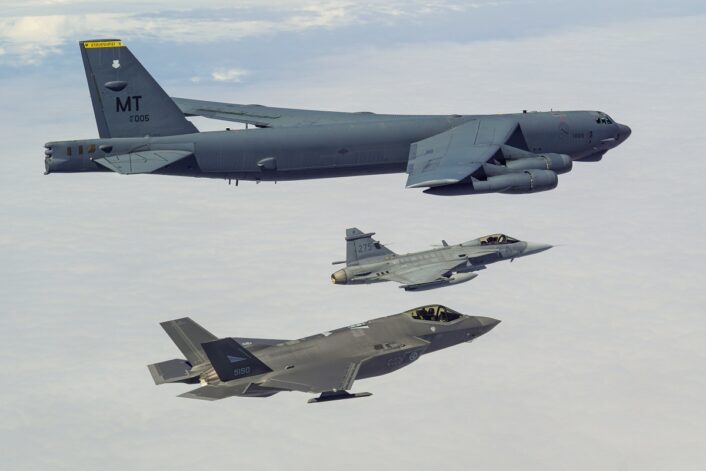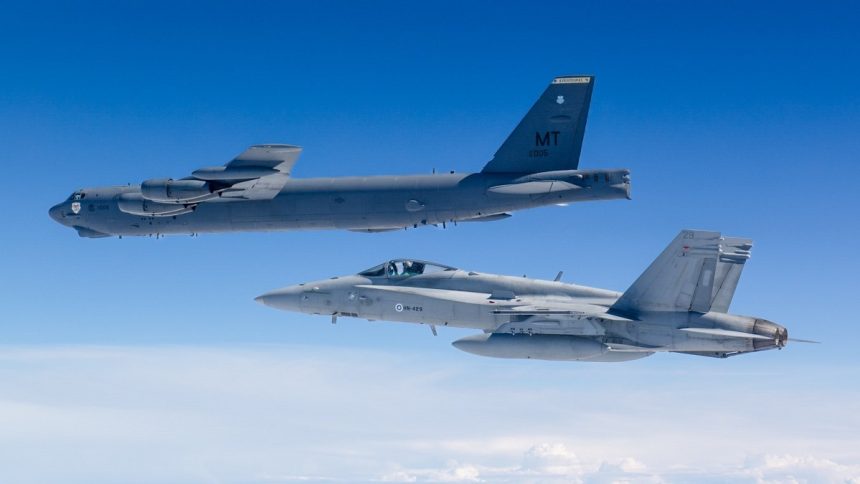The first two bombers returned to Minot Air Force Base a month after their arrival in the U.K., integrating with Swedish, Norwegian and Finnish assets on their way back.
After a month in the United Kingdom, the first two B-52H Stratofortress bombers deployed to RAF Fairford for Bomber Task Force 24-3 returned to Minot Air Force Base, North Dakota, on Jun. 18, 2024. After leaving Fairford, the two bombers toured the Scandinavian peninsula, before beginning the Atlantic crossing on their way back.
The mission to the Nordic region came few days after the first reported violations by Russian combat aircraft of the airspaces of Sweden and Finland, since the two nations have joined NATO.
The two bombers, assigned to the 69th Expeditionary Bomb Squadron, were part of a four-aircraft deployment which started on May 20, while the first missions in support of the Bomber Task Force were flown on May 24. As for previous BTF deployments, the goal was to demonstrate the shared commitment to global security and stability, as well as to conduct strategic training focusing on interoperability across the area of responsibility.
Yesterday 🇳🇴Norwegian F-35s conducted a Bomber Task Force training mission with 🇺🇸B-52 bomber together with 🇸🇪Swedish JAS-Gripen and 🇫🇮Finnish F/A-18 Hornet on the coast of Norway.#GlobalGuardian #JEFtogether #StrongerTogether pic.twitter.com/dPNVI0siRY
— Norwegian Armed Forces | Forsvaret (@Forsvaret_no) June 19, 2024
This focus on integration is critical for partner building and maintaining the collective stability of Euro-Atlantic relations, said U.S. Air Force Lt. Col. Ryan Ruedier, 69th EBS director of operations. “Through multiple iterations of integrating with Allies in the region, we learn to work together as seamlessly and efficiently as possible,” said Ruediger. “The missions we’ll fly here allow us to identify limiting factors and increase interoperability to the maximum extent possible.”
In the framework of the continued integration with all the Allies, the B-52s, callsigns COKE 11 and COKE 12, integrated on Jun. 18 with Swedish Gripens, Norwegian F-35s and Finnish F/A-18s. The bombers were supported by two KC-135s from RAF Mildenhall on their way to Norway, before being met by three other KC-135s to refuel in preparation for the Atlantic crossing.
🇫🇮Finnish Air Force F/A-18 Hornet fighters flew a training mission with a 🇺🇸 B-52 bomber and 🇳🇴 @Luftforsvaret F-35 fighters off the coast of Norway on 18 June.
#ilmavoimat #GlobalGuardian #JEFtogether #StrongerTogether pic.twitter.com/3yICTgxb2H
— Ilmavoimat (@FinnishAirForce) June 19, 2024
The bombers, according to flight tracking, flew along the North Sea’s coasts escorted by fighters. An E-3 AWACS was also orbiting over Sweden at the same time, although it is unknown if it was related to the BTF mission. Interestingly, in the same area were also present the Swedish Air Force Argus C604 AEW&C aircraft and the test platform for the Saab Erieye.
“The main objective for us being here is to show support to our allies, NATO, and provide training to our aircrews on certain aspects of what the B-52 can provide,” said U.S. Air Force Master Sgt. Parnel Brim, 69th Aircraft Maintenance Unit production superintendent. “Specifically because we have moved from our home station, everyone is watching us while we are out here”.
Three different version of airborne command and control in one screenshot.
Trusty AWACS, Swedish present generation SAAB AEW&C system and coming generation Erieye on the test platform SERMV. One on live mission, one exercising(?) and one testing.
Thanks @bizjetsofwar ! pic.twitter.com/nkoreOF7AO
— Markus Jonsson (@auonsson) June 18, 2024
Similar to previous deployments, the B-52s have conducted missions in the Baltics, Eastern Europe, and North Africa. Some of these missions could be tracked online using flight tracking websites, and the bombers were regularly observed by many along with their supporting tankers.
BTF 24-3 was also part of the Large Scale Global Exercise 2024, a comprehensive initiative that links military operations across various combatant commands. LSGE24 enables U.S. Joint Forces to train with Allies and partners, fostering shared understanding, trust, and interoperability in addressing global security challenges.
After about a month of operations in Europe, two of four B-52 bombers (60-0005 and 61-0018) returned to their home base at Minot. pic.twitter.com/xzbow5sSN7
— Hans Kristensen (@nukestrat) June 19, 2024
The Air Force might fly the B-52 until 2060
The BUFF (Big Ugly Fat Fellow) is about to undergo the largest modification program in its history. The U.S. Air Force plans to finalize integration activities and deliver the first lot of modified Stratofortress bomber, designated B-52J, in the 2026-2027 timeframe, with initial operational capability expected in 2030. Thanks to new RR F130 engines, selected in 2021 to replace the bomber’s Pratt & Whitney TF33-PW-103s used on the Stratofortress fleet since the 1960s, the Air Force will be able to fly the iconic bomber through at least 2050, possibly 2060, increasing fuel efficiency and range, reducing emissions in unburned hydrocarbons, and significantly reducing maintenance costs.

Another interesting upgrade to the B-52 is the new radar, a modified valiant of the F/A-18E/F Super Hornet’s APG-79 AESA radar. This will give the B-52s greatly improved radar range and situational awareness, while taking less space than the older mechanically scanned radar, thus leaving room for electronic warfare functions.
Thanks to the APG-79, the B-52s will feature greatly improved radar range and situational awareness along with the capability to slave the targeting pod to the radar and vice versa, for target acquisition and identification.
One major external difference is the presence of two large humps over the fuselage, near the wing roots. A Boeing spokesperson said the humps are not new and not part of their upgrade program, however, when pressed, hinted that they could host classified equipment. Based on shape and position, it is being reported that they could be associated with wideband satellite communications systems.
Externally, the B-52 will also have a cleaner look, as the blisters that currently house the AN/ASQ-151 Electro-Optical Viewing System (EVS) will be removed: the EVS was used to help crews fly safely at very low altitudes, but it was largely supplanted by the Litening and Sniper targeting pods installed on pylons under the bomber’s left wing.
Inside the cockpit, the BUFF is also getting an upgrade, with new MFDs (multifunction digital displays), hybrid mechanical-to-digital throttle system, new data concentrators units new engine fault maintenance recorder, new engine air data system and all the related updates in panels, consoles and wirings. It won’t be a full glass cockpit though, as some of the analogue instruments are going to remain. What’s also going to disappear is one of the crew member stations, as the total crew is reduced to four members, instead of the current five.
Initially, the B-52J was supposed to be able to use the hypersonic AGM-183 Air-Launched Rapid Response Weapon (ARRW), the U.S. Air Force is planning to abandon the ARRW hypersonic weapon program after the last two test flights of the prototyping phase and focus instead on the Hypersonic Attack Cruise Missile (HACM).









